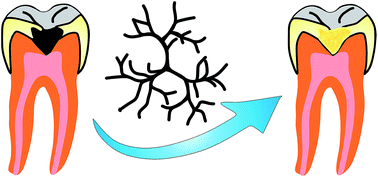Functional dendritic compounds: potential prospective candidates for dental restorative materials and in situ re-mineralization of human tooth enamel
Abstract
Dental caries and dentin hypersensitivity are the most common clinical diseases in oral health worldwide. Depending on the extent of tooth damage, various approaches can be used to repair teeth. When caries break in more than half of the tooth enamel, a dentist removes the decayed materials and replaces it with appropriate materials. The most commonly used restorative materials are amalgam, dental porcelain (dental ceramic), gold, glass ionomer, and resin-based composites. It is a decisive fact that a great deal of research effort has focused on the design of new photoinitiators, monomers, and telechelic oligomers in the field of resin-based dental composites in order to achieve interesting materials with improved physicochemical properties. In this respect, a novel achievement with multifunctional dendrimers is their dental restorative materials performance, because they exhibit suitable polymer mechanical properties, and reduce shrinkage or shrinkage stress when compared with other similar molecular weight molecules. They possess a high number of functional end groups, and a high degree of conversion. Furthermore, in dendrimer-based dental restorative materials the high cross-link density, as a result of the large number of reactive functional end groups provide some advantages such as a three-dimensional network, decreases solubility and water sorption, improve the mechanical and thermal properties of the resin. Moreover, multifunctional dendrimers can be used in regeneration of human tooth enamel. From the practical point of view, approximately all conducted research in this area has been focused on regeneration of human tooth enamel by a poly(amido amine) (PAMAM) dendrimer, in part due to the capability of this dendrimer in the crystallization process of hydroxyapatite (HA). This review provides a snapshot of recent progress in the synthesis and application of dendrimers in dental restorative materials, and in situ re-mineralization of human tooth enamel.


 Please wait while we load your content...
Please wait while we load your content...